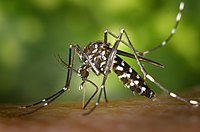
Photo from wikipedia
Mosquito vector species (Diptera: Culicidae) are responsible for the transmission of many pathogens and parasites to humans and animals. Current predictions indicate that more than half of the human population… Click to show full abstract
Mosquito vector species (Diptera: Culicidae) are responsible for the transmission of many pathogens and parasites to humans and animals. Current predictions indicate that more than half of the human population on the planet is at risk of vector-borne infections [1]. Most of the mosquito vectors responsible for transmitting diseases are invasive species [2]. Invasive mosquitoes of epidemiological importance, such as Aedes aegypti (L.), A. albopictus (Skuse), and Culex quinquefasciatus Say, are more likely to adapt and thrive in urban environments in low-latitude parts of the world in comparison with native species [3,4]. Moreover, invasive species often benefit from biotic homogenization processes and from the reduction in overall biodiversity by being able to increase their range and abundance in the process [3,5–7]. The substantial increase in the incidence of vector-borne diseases can be partially attributed to these factors [2]. In this viewpoint paper, we focus on two highly invasive alien mosquito species: A. albopictus in Europe and C. coronator Dyar and Knab in America, shedding light on key biological, ecological, and epidemiological issues urgently needing further attention at the forefront of vector biology and control research.
Journal Title: PLoS Neglected Tropical Diseases
Year Published: 2020
Link to full text (if available)
Share on Social Media: Sign Up to like & get
recommendations!